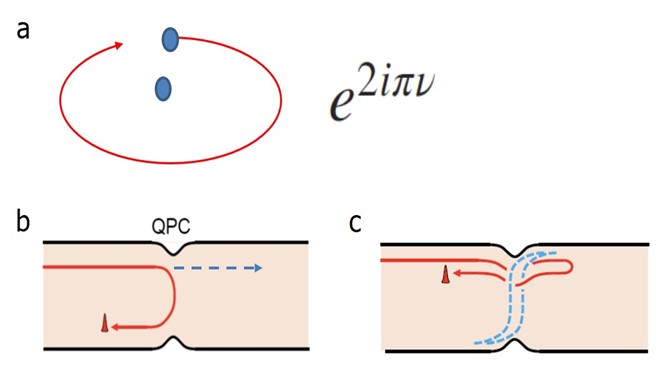| [Physics]Partitioning of diluted anyons reveals their braiding statistics | ||
|
||
|
All the known quantum particles are either bosons or fermions. It has been predicted that in two dimensions there exist particles not belonging to the categories of bosons or fermions. These, dubbed anyons, obey fractional (Abelian or non-Abelian) braiding statistics. The present work observed an essential signature, the braiding statistics, of Abelian anyons in fractional quantum Hall systems, by partitioning a diluted particle beam at a beam splitter and measuring the partition noise.
Quantum particles, existing in three dimensions, are either bosons or fermions. Any wave function of two identical bosons (resp. fermions) gains the quantum phase factor of +1 (-1), when the positions are adiabatically exchanged. This fundamental behavior is called bosonic (fermionic) exchange statistics. It has been predicted that, in two dimensions, there exist particles that do not belong to the categories of bosons or fermions. The candidates include excitations in the fractional quantum Hall effects and Majorana modes in topological superconductors. These, dubbed anyons, obey the fractional (Abelian or non-Abelian) braiding statistics: When an anyon circulates (braids) once around another in two dimensions, their state gains a nontrivial phase factor in cases of Abelian anyons or evolves into another state for non-Abelian anyons. See Fig. (a). By contrast, for bosons and fermions, the braiding results in only the trivial phase factor +1 to the wave function, as the braiding is equivalent to double position exchanges of the particles. There have been long-time efforts to find anyon signatures, especially the braiding statistics. The first experimental signature was recently observed by a French group [Bartolomei et al., Science 368, 173 (2020)]. They injected two diluted beams into a beam splitter and measured the resulting partition noise. The noise could not be understood with bosons and fermions, implying new particles. They interpreted the noise as a signal of anyon collision. This interpretation is in accordance with the conventional wisdom of the community [Rosenow, Levkivskyi, and Halperin, Phys. Rev. Lett. 116, 156802 (2016)]. However, the interpretation is incorrect, according to a theory developed by a research team at the Physics department at KAIST led by Prof. Heung-Sun Sim [Lee, Han, and Sim, Phys. Rev. Lett. 123, 016803 (2019); Lee and Sim, Nat. Comm. 13, 6660 (2022)]. The team showed that a new process, involving anyon braiding, happens at the partition and determines the observed noise, dominating over the conventional collision process. The team further proposed a simple (maybe the simplest) partition setup for observing Abelian and non-Abelian anyonic braiding statistics. In the setup proposed by the KAIST team [see Figs. (b,c)], a diluted anyon beam propagates along a fractional quantum Hall edge channel toward a beam splitter, known as a quantum point contact (QPC), at which anyon tunneling happens from that channel to another channel. In the conventional process, an injected anyon either propagates along the injection channel (forward transmission) or tunnels to the other channel (backward reflection), as in bosons and fermions [Fig. (b)]. By contrast, in the new partition process of the KAIST team, the injected anyon propagates along the injection channel without tunneling, and instead another anyon is excited at the QPC and effectively braids the injected anyon in time domain [Fig. (c)]. Bosons and fermions never exhibit this behavior. To see experimental signatures of the new partition process, the KAIST team collaborated with an experimental group at the Weizmann Institute of Science, Israel, led by Prof. Moty Heiblum. The partition noise of electrical currents, observed in the proposed setup, was found to be in good agreement with the theory of the KAIST team over a wide range of parameters and without any fitting parameter, according to the analysis by the team. The observed noise provided evidence of the braiding statistics of an Abelian anyon carrying 1/3 of the electron charge (a fractional charge). The collaboration results were published in Nature [Lee, Hong, Alkalay, Schiller, Umansky, Heiblum, Oreg, and Sim, Nature 617, 277 (2023)]. The anyon observed in the present work is the simplest and most stable Abelian anyon. The experimental setup established in the work will be applicable to other, more exotic, and hence more elusive anyons, including non-Abelian anyons that remain so far undiscovered.
Figure (a) Braiding of Abelian anyons. An Abelian anyon circulates around another in two dimensions. After one circulation, their wave function gains a nontrivial phase factor (different from +1), shown in the figure, although the particles are located at their initial positions. (b) Partitioning of a bosonic or fermionic particle at a beam splitter (QPC). The particle is either transmitted or reflected at the QPC. (c) Partitioning of an anyon at a QPC. This involves the braiding effect, in which an anyon excited at the QPC effectively braids the injected particle in time domain. This results in nontrivial partitioning noise. Bosons and fermions never show this noise. #Anyons #Anyonic braiding statistics #Fractional quantum Hall effects #Bosons #Fermions Web address for full article : https://www.nature.com/articles/s41586-023-05883-2 the Name of Journal : Nature Laboratory web-address of the author : https://qet.kaist.ac.kr/ |
||
|




